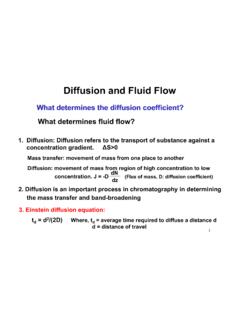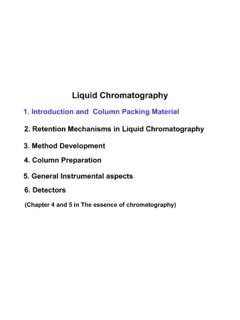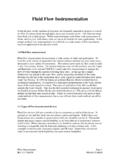Transcription of Fluid Flow in Packed Beds - University of Florida
1 Fluid Flow in Packed Beds:1. Flow in a Packed bed involves a complex pattern of solvent traveling in and around spaces in the support materials, through channels or pores of various sizes and The basic structure of a Packed bed is made up of three regions(a) Flowing mobile phase: the solvent which is flowing freely through the column, located outside the pores of the support material. (b) Stagnant mobile phase: the solvent which is near the surface of the support or in it pores and which does not travel freely through the column (it is significant in liquid chromatography).(c) Support material and stationary phase3. Measure of amount of space occupied by solvent or solid support in a Packed bed: porosities. There are three types of porosities used to describe a Packed bed(a) Intraparticle porosity ( p): the fraction of the column volume occupied solvent inside the pores of the support or directly in contact with its surface ( , the stagnant mobile phase).
2 P =Pore Volume of the columnEmpty column volumeFor most porous support materials, p ~ (b) Interparticle porosity ( e): the fraction of the column volume occupied by solvent in the column but excluded or outside of the support materials ( , the flowing mobile phase) e =Volume outside of supportEmpty column volumeFor uniform spherical supports, e ~ : A 25 cm x mm ID liquid chromatography column is Packed with spherical particles that are 10 microns in diameter and pore size range of 8 nm ~ 10 nm. The mobile phase is water, flowing at 1 mL/min. Two aqueous samples are injected separately onto the column. This first contains acetone, which eluted at min. The second contrains a large polymer, which elutes at min. Neither of these solutes interacts with the spherical particles in the bed. What are the values of the intra-, inter, and total porosities of this system? What would you predict the linear velocity of water to be in this system?
3 (C) Total porosity ( e): the total fraction of the column volume occupied by solvent. tot =Void volume of columnEmpty column volumeFor most porous supports, tot ~ ( , 80% of the average column is occupied by mobile phase and 20% by the solid Flow in Packed beds, as in open tubes, can be characterized by Reynolds number (Re), where dpis now set equal to the diameter of the particles in the Packed bed. In order words, for a Packed bed the average width of each flow channel is assumed to be the same as the width of one support = u dp/ Where: = solvent density (g/cm3)u = solvent linear velocity (cm/sec)dp= diameter of the particles in a Packed -bed system(cm) = solvent viscosity (poise)5. Due to the complex flow pattern in Packed beds, the values of Rethat characterize turbulent vs. laminar flow are not as well as defined as they are in open tubes. However, the following guidelines are general considered to be flow only: Re>100 Laminar + turbulent flow: Re= 1 to 100 Laminar flow only: Re< 16.)
4 The presence of a solid support in the Packed bed creates resistance to solvent flow. The result is that it is more difficult to move a solvent through a Packed bed at a given flow-rate than it is to move it through an open tube. Open tubePacked bed7. The degree of flow resistance in any medium is given by Bothe specific permeability coefficient. Bois usually given in units of cm2, or Darcy unit (where 1 Darcy = 10-8cm2).8. For any Packed bed containing solid support, the average linear velocity (uAvg) of solvent in the bed in given by Darcy s P Bo/( e L)Where: P = pressure drop across the tube ( , P at inlet P at the outlet) = solvent viscosity; L = tube length; e= inter-particle porosity9. For a a Packed bed containing spherical particles, the value of Bo can be determined by using the Konzeny-Carman equation: Bo = dp2* e3/[180(1- e)2]Where: dp = diameter of the particles10. Using the Kozeny-Carman equation, the resulting Darcy equation for a spherical particles becomesuAvg= P dp2* e2/[180 (1- e)2L]The equation assumes laminar flow and a value for e< equation is in predicting what pressure is needed for force solvent through a Packed bed at a given velocity.
5 This can be useful in designing new systems for liquid or gas :A 10 cm x mm ID liquid chromatography column Packed with 10 micron particles produces a total in pressure of 500 psi between its inlet and outlet when water as the mobile phase at 1 mL/min. A chromatographer wants to use the same packing materials in a column that is 2 m x 1 mm ID. If the maximum pressure difference that can be created across such a column is 4000 psi, what is the flow-rate that can be used with water as the mobile phase?







